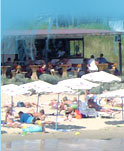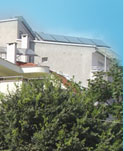
NESEBAR
ARCHAEOLOGICAL MUSEUM
Nessebur, located on a small rocky peninsula, is one of the most picturesque towns along the Bulgarian Black Sea coast, while its thousand-year old history and numerous cultural monuments are the reason for its taking a very special place in both Bulgarian and European science and culture. The town of Nessebur was established at the end of 2 000 B.C. by the Thracians. Greek colonizers turned it into a Greek Polis (a city-state) at the end of 6th c. B.C.; Rome joined it to the Empire in 1st c. B.C.; and A.D. 4th c. saw Nessebur within the frontiers of Byzantium. Nessebur, conquered by the Bulgarians in 812, reached its new zenith between the 13 and 15th centuries. Together with Constantinople, the capital of Byzantium, fell under the reign of the Osman Turks in 1453. In 1878 Nessebur welcomed the Russian liberation troops.
The archaeological study of the Nessebur peninsula and its aquatory done during the last four decades revealed rich collections of significant cultural monuments illustrating the history of ancient Messambria and medieval Nessebur. A large part of them are present exhibits in the new Nessebur archaeological museum. The museum exhibition area includes a foyer and four halls. The UNESCO Diploma, certifying the Ancient Nessebur registration on the world cultural heritage list in 1983, can be seen in the foyer.
HALL ONE - MESSAMBRIA AND THE THRACIANS
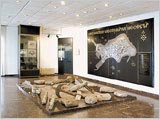 The archaeological study of the Nessebur peninsula and its aquatory done during the last four decades revealed rich collections of significant cultural monuments illustrating the history of ancient Messambria and medieval Nessebur. A large part of them are present exhibits in the new Nessebur archaeological museum. The museum exhibition area includes a foyer and four halls. The UNESCO Diploma, certifying the Ancient Nessebur registration on the world cultural heritage list in 1983, can be seen in the foyer. The archaeological study of the Nessebur peninsula and its aquatory done during the last four decades revealed rich collections of significant cultural monuments illustrating the history of ancient Messambria and medieval Nessebur. A large part of them are present exhibits in the new Nessebur archaeological museum. The museum exhibition area includes a foyer and four halls. The UNESCO Diploma, certifying the Ancient Nessebur registration on the world cultural heritage list in 1983, can be seen in the foyer.
HALL TWO - MESSAMBRIA, THE PONTIC POLIS
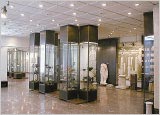 After the peninsula was colonized by settlers coming from the town of Megara and its colonies Byzantium and Calchedon at the end of 6th c. B.C., Pontic Messambria became polis of a Greek type closely connected to the way of life and culture of the peoples inhabiting the coastal areas of the Mediterranean, the Sea of Marmora and the Black Sea. Numerous monuments dated to 6-2 nd c. B.C. serve as an illustrative picture of the large trade connections, the spiritual and cultural life as well as artistic crafts flourishing in this small Thracian coastal town. After the peninsula was colonized by settlers coming from the town of Megara and its colonies Byzantium and Calchedon at the end of 6th c. B.C., Pontic Messambria became polis of a Greek type closely connected to the way of life and culture of the peoples inhabiting the coastal areas of the Mediterranean, the Sea of Marmora and the Black Sea. Numerous monuments dated to 6-2 nd c. B.C. serve as an illustrative picture of the large trade connections, the spiritual and cultural life as well as artistic crafts flourishing in this small Thracian coastal town.
HALL THREE - MESSEMBRIA WITH IN THE LIMITS OF ROME, BYZANTIUM AND BULGARIA
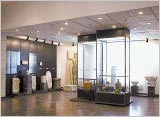 Messembria continued trading, minting coins, developing local crafts during the Roman reign. The pottery covered with red varnish, the marble funeral gravestones and the votive reliefs of Hercules and the Thracian Horseman are all dated back to this epoch. Another monument of interest is the marble pedestal for a bronze statue of Claudius I (A.D. 41-54) placed there by Gneus, son of Gneus, the town gymnasiarch Messembria continued trading, minting coins, developing local crafts during the Roman reign. The pottery covered with red varnish, the marble funeral gravestones and the votive reliefs of Hercules and the Thracian Horseman are all dated back to this epoch. Another monument of interest is the marble pedestal for a bronze statue of Claudius I (A.D. 41-54) placed there by Gneus, son of Gneus, the town gymnasiarch
HALL FOUR - ICONS
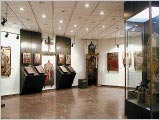 A collection of Nessebur icons, brilliant examples of Bulgarian iconography dated to 13-19th centuries, is exhibited in the hall. These icons decorated the iconostases of the numerous Nessebur churches. The icons below are referred to the royal row of the iconostasis: the Virgin Mary under various names (Gracious, Protectress, etc.), St. Dimitar, St. Elephteri, Christ Pantokra-tor, Christo Archbishop. To the festive row of the iconostasis are referred : the Assumption, Christmas, the Ascension, and other saints and prophets. Also exhibited are: royal gates, episcopal throne, choirbook, and other church furniture as well as icons with a silver repousse cover. A collection of Nessebur icons, brilliant examples of Bulgarian iconography dated to 13-19th centuries, is exhibited in the hall. These icons decorated the iconostases of the numerous Nessebur churches. The icons below are referred to the royal row of the iconostasis: the Virgin Mary under various names (Gracious, Protectress, etc.), St. Dimitar, St. Elephteri, Christ Pantokra-tor, Christo Archbishop. To the festive row of the iconostasis are referred : the Assumption, Christmas, the Ascension, and other saints and prophets. Also exhibited are: royal gates, episcopal throne, choirbook, and other church furniture as well as icons with a silver repousse cover.
CHURCH ST. STEPHAN
 The church of St. Stephan / New metropolitan church / is one of the most attractive cultural monuments for the visitors of the ancient town of Nessebar. The church of St. Stephan / New metropolitan church / is one of the most attractive cultural monuments for the visitors of the ancient town of Nessebar.
It is remarkable by its original architecture and rich internal decoration. Built XI - XVIII century, the church endured some reconstructions. The sixteenth century the church was prolonged on the west, XVIII the narthex was added. The church is a three nave basilica, long 12 m and wide 9,5 m. A column, pylons, supported arches separate the naves, which are terminated by an apse in east. The central nave rises above the external and finishes with frontons in east and west. The construction is of stone and bricks. Decorative glazed rosettes and circles, old architectural elements and inscriptions were used.
The date of painting is 1599. The church was dedicated to the Holly Mother; we can see that from the portrait of the donator Christopher bishop and exarh of all Black Sea region, represented kneeling in front of the Holly Mother.
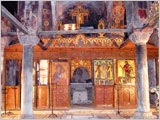 There are 1000 figures and 258 compositions in the churches. The theme of the pictures is from the life of Virgin and Christ: “Holly Mother with the new born child on throne”, “the Assumption”, “Presentation of the Blessed Virgin”. Scenes with miracles of Christ are given in series of legends from the Gospel: Christ cures mentally ills and others, resurrects dead persons, calms the sea storm, helps fishermen etc. There are many curative subjects and this is linked with famous healing properties of Nessebar beach. There are many scenes from the lives of St. John Theologian and St. John the Baptist etc. There are 1000 figures and 258 compositions in the churches. The theme of the pictures is from the life of Virgin and Christ: “Holly Mother with the new born child on throne”, “the Assumption”, “Presentation of the Blessed Virgin”. Scenes with miracles of Christ are given in series of legends from the Gospel: Christ cures mentally ills and others, resurrects dead persons, calms the sea storm, helps fishermen etc. There are many curative subjects and this is linked with famous healing properties of Nessebar beach. There are many scenes from the lives of St. John Theologian and St. John the Baptist etc.
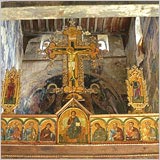 In the beginning of XVIII-eth c. the scene “The Last Judgment” was painted in a traditional iconography on the eastern wall of the narthex. Original painted iconostasis in style “tulip” from XVI c. is well preserved in the church. The throne and the pulpit are from the XVIII -eth c. They are decorated with golden woodcarvings. In the beginning of XVIII-eth c. the scene “The Last Judgment” was painted in a traditional iconography on the eastern wall of the narthex. Original painted iconostasis in style “tulip” from XVI c. is well preserved in the church. The throne and the pulpit are from the XVIII -eth c. They are decorated with golden woodcarvings.
CHURCH ST. SPASS
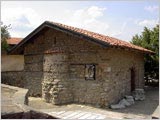 The church is 11,70m long and 5,70m wide building with an apse. It has been built in 1609. The church is 11,70m long and 5,70m wide building with an apse. It has been built in 1609.
A memorial inscription over the south wall saying: “This heavenly church of our lady the Holy Mary, named later the Ascension, was painted in the time of His Holiness the Bishop of the Holy Metropolia Messambria, Mr. Kiprian, and the most religious among the priests, Mr. Agripius, at the expense of the most kind master Theotoki Kapaduka, for the benefit and mental salvation of his own soul and for the consolation of the devout and contributory men and women...1609”. Inside the walls are almost completely covered with mural paintings. The scene: “Virgin Mary with the new born child in expanse” is in the apse.
 On the south wall are situated the following compositions: Christening, Transfiguration, Lazarus Resurrection, Entering in Jerusalem, Washing the feet. On the next level underneath are painted the figures of some saints: St.Anastasia, St.Katherine, St.Matron, and St.Marina. On the south wall are situated the following compositions: Christening, Transfiguration, Lazarus Resurrection, Entering in Jerusalem, Washing the feet. On the next level underneath are painted the figures of some saints: St.Anastasia, St.Katherine, St.Matron, and St.Marina.
On the north wall the compositions and figured paintings are also situated on two levels. On the upper level are preserved the following compositions: The Resurrection, Doubting Thomas, The Ascension, The Descent of the Holy Spirit, The Assumption, The Birth of Virgin Mary, Presentation of the Blessed Virgin, St.Joachim and St.Anthony. On the lower level are painted the figures of the saints: St.Jacob, St.Mina, St.Eustatius, St.Nestor, St.Arthemius, St.Procopius, St.Theodor Typon, St.Theodor Stratilatus and Archangel Michael.
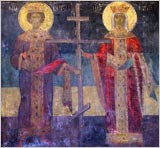 On the floor of the church there is a gravestone of the Byzantine princess Mataissa Cantacuzina. The inscription says: “Here rests in peace the God's servant Mataissa Cantacuzina Paleologhina, who died in November-indict V, 1441”. She was buried in the old Metropolitan church. The gravestone has been placed in the church St.Spas by the Metropolitan Bishop, because he has been afraid of the Turks who could use it as a building material. On the floor of the church there is a gravestone of the Byzantine princess Mataissa Cantacuzina. The inscription says: “Here rests in peace the God's servant Mataissa Cantacuzina Paleologhina, who died in November-indict V, 1441”. She was buried in the old Metropolitan church. The gravestone has been placed in the church St.Spas by the Metropolitan Bishop, because he has been afraid of the Turks who could use it as a building material.
Although having no architectural value the church “St.Spas” has well preserved and restored mural paintings and it is a striking example of the talent and genius of the artists, working at that time in the town pictorial studios.
|
 |
